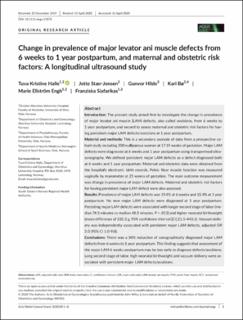| dc.contributor.author | Halle, Tuva Kristine Toresdatter | |
| dc.contributor.author | Stær-Jensen, Jette | |
| dc.contributor.author | Hilde, Gunvor | |
| dc.contributor.author | Bø, Kari | |
| dc.contributor.author | Engh, Marie Ellström | |
| dc.contributor.author | Siafarikas, Franziska | |
| dc.date.accessioned | 2020-07-10T06:24:40Z | |
| dc.date.available | 2020-07-10T06:24:40Z | |
| dc.date.created | 2020-05-04T10:24:29Z | |
| dc.date.issued | 2020 | |
| dc.identifier.citation | Acta Obstetricia et Gynecologica Scandinavica. 2020. | en_US |
| dc.identifier.issn | 0001-6349 | |
| dc.identifier.uri | https://hdl.handle.net/11250/2663631 | |
| dc.description | This is an open access article under the terms of the Creative Commons Attribution-NonCommercial-NoDerivs License, which permits use and distribution in any medium, provided the original work is properly cited, the use is non-commercial and no modifications or adaptations are made. | en_US |
| dc.description.abstract | Introduction: The present study aimed first to investigate the change in prevalence of major levator ani muscle (LAM) defects, also called avulsions, from 6 weeks to 1 year postpartum, and second to assess maternal and obstetric risk factors for having persistent major LAM defects/avulsions at 1 year postpartum. Material and methods: This is a secondary analysis of data from a prospective cohort study including 300 nulliparous women at 17-19 weeks of gestation. Major LAM defects were diagnosed at 6 weeks and 1 year postpartum using transperineal ultrasonography. We defined persistent major LAM defects as a defect diagnosed both at 6 weeks and 1 year postpartum. Maternal and obstetric data were obtained from the hospital's electronic birth records. Pelvic floor muscle function was measured vaginally by manometer at 21 weeks of gestation. The main outcome measurement was change in prevalence of major LAM defects. Maternal and obstetric risk factors for having persistent major LAM defect were also assessed. Results: Prevalence of major LAM defects was 19.4% at 6 weeks and 10.4% at 1 year postpartum. No new major LAM defects were diagnosed at 1 year postpartum. Persisting major LAM defects were associated with longer second stage of labor (median 74.5 minutes vs median 48.0 minutes, P = .012) and higher neonatal birthweight (mean difference of 232.3 g, 95% confidence interval [CI] 21.5-443.1). Vacuum delivery was independently associated with persistent major LAM defects, adjusted OR 3.0 (95% CI 1.0-9.0). Conclusions: There was a 50% reduction of sonographically diagnosed major LAM defects from 6 weeks to 1 year postpartum. This finding suggests that assessment of the major LAM 6 weeks postpartum may be too early to diagnose defects/avulsions. Long second stage of labor, high neonatal birthweight and vacuum delivery were associated with persistent major LAM defects/avulsions. | en_US |
| dc.language.iso | eng | en_US |
| dc.subject | levator ani muscle avulsion | en_US |
| dc.subject | levator ani muscle defect | en_US |
| dc.subject | maternal and obstetric risk factors | en_US |
| dc.subject | pelvic floor disorder | en_US |
| dc.subject | transperineal ultrasound | en_US |
| dc.subject | vacuum extraction delivery | en_US |
| dc.title | Change in prevalence of major levator ani muscle defects from six weeks to one year postpartum, and maternal and obstetric risk factors : a longitudinal ultrasound study | en_US |
| dc.type | Peer reviewed | en_US |
| dc.type | Journal article | en_US |
| dc.description.version | publishedVersion | en_US |
| dc.rights.holder | © 2020 The Authors. | en_US |
| dc.source.pagenumber | 8 | en_US |
| dc.source.journal | Acta Obstetricia et Gynecologica Scandinavica | en_US |
| dc.identifier.doi | 10.1111/aogs.13878 | |
| dc.identifier.cristin | 1809177 | |
| dc.description.localcode | Institutt for idrettsmedisinske fag / Department of Sports Medicine | en_US |
| cristin.ispublished | false | |
| cristin.fulltext | original | |
| cristin.qualitycode | 1 | |
